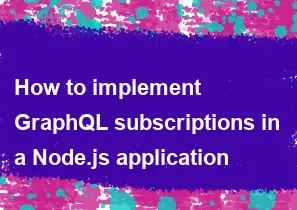How to implement GraphQL subscriptions in a Node.js application

Implementing GraphQL subscriptions in a Node.js application involves using a combination of technologies and libraries to handle real-time updates. Here's a step-by-step guide on how to implement GraphQL subscriptions in a Node.js application using popular tools like Apollo Server and GraphQL subscriptions:
Setup your Node.js project: Ensure you have Node.js installed. Create a new project or navigate to your existing project directory.
bashmkdir my-graphql-app cd my-graphql-app npm init -yInstall required packages: Install the necessary packages using npm. You'll need
express,apollo-server-express, andgraphqlfor the basic GraphQL server. Additionally, you'll needsubscriptions-transport-wsfor WebSocket support.bashnpm install express apollo-server-express graphql subscriptions-transport-wsCreate an Express server: Set up a basic Express server with Apollo Server integration.
javascript// index.js const express = require('express'); const { ApolloServer } = require('apollo-server-express'); const { createServer } = require('http'); const { SubscriptionServer } = require('subscriptions-transport-ws'); const { execute, subscribe } = require('graphql'); const typeDefs = /* Your GraphQL schema */; const resolvers = /* Your GraphQL resolvers */; const server = new ApolloServer({ typeDefs, resolvers, subscriptions: { path: '/subscriptions', }, }); const app = express(); server.applyMiddleware({ app }); const httpServer = createServer(app); // Set up WebSocket server for subscriptions SubscriptionServer.create( { execute, subscribe, schema: server.schema }, { server: httpServer, path: '/subscriptions' } ); httpServer.listen({ port: 4000 }, () => { console.log(`Server ready at http://localhost:4000${server.graphqlPath}`); console.log(`Subscriptions ready at ws://localhost:4000${server.subscriptionsPath}`); });Define your GraphQL schema and resolvers: Create your GraphQL schema and resolvers. Ensure you include subscription types in your schema.
javascript// schema.js const { gql } = require('apollo-server-express'); const typeDefs = gql` type Query { hello: String } type Subscription { messageAdded: String } `; const resolvers = { Query: { hello: () => 'Hello, world!', }, Subscription: { messageAdded: { subscribe: () => pubsub.asyncIterator('MESSAGE_ADDED'), }, }, }; module.exports = { typeDefs, resolvers };Handle subscriptions with PubSub: Use the
graphql-subscriptionslibrary'sPubSubto manage subscriptions.javascript// index.js const { ApolloServer, PubSub } = require('apollo-server-express'); const { createServer } = require('http'); const { SubscriptionServer } = require('subscriptions-transport-ws'); const { execute, subscribe } = require('graphql'); const { typeDefs, resolvers } = require('./schema'); const pubsub = new PubSub(); const server = new ApolloServer({ typeDefs, resolvers, context: { pubsub }, subscriptions: { path: '/subscriptions', }, }); // ...In your resolvers, you can use
pubsub.publishto send messages to subscribers.javascript// resolvers.js const resolvers = { Query: { hello: () => 'Hello, world!', }, Subscription: { messageAdded: { subscribe: () => pubsub.asyncIterator('MESSAGE_ADDED'), }, }, Mutation: { addMessage: (_, { message }) => { pubsub.publish('MESSAGE_ADDED', { messageAdded: message }); return message; }, }, };Test your subscriptions: Start your server and test the subscriptions using a tool like GraphQL Playground or Apollo Client.
Open GraphQL Playground at
http://localhost:4000/graphql.Run a subscription query:
graphqlsubscription { messageAdded }In another tab, run a mutation to trigger the subscription:
graphqlmutation { addMessage(message: "New message!") }
You should see the subscription updating with the new message.
This example uses Apollo Server, Express, and subscriptions-transport-ws for WebSocket support. Adjust the code as needed based on your specific requirements and chosen GraphQL server implementation.
-
Popular Post
- How to optimize for Google's About This Result feature for local businesses
- How to implement multi-language support in an Express.js application
- How to handle and optimize for changes in mobile search behavior
- How to handle CORS in a Node.js application
- How to use Vue.js with a UI framework (e.g., Vuetify, Element UI)
- How to configure Laravel Telescope for monitoring and profiling API requests
- How to create a command-line tool using the Commander.js library in Node.js
- How to implement code splitting in a React.js application
- How to use the AWS SDK for Node.js to interact with various AWS services
- How to use the Node.js Stream API for efficient data processing
- How to implement a cookie parser middleware in Node.js
- How to implement WebSockets for real-time communication in React
-
Latest Post
- How to implement a dynamic form with dynamic field styling based on user input in Next.js
- How to create a custom hook for handling user interactions with the browser's device motion in Next.js
- How to create a custom hook for handling user interactions with the browser's battery status in Next.js
- How to implement a dynamic form with dynamic field visibility based on user input in Next.js
- How to implement a dynamic form with real-time collaboration features in Next.js
- How to create a custom hook for handling user interactions with the browser's media devices in Next.js
- How to use the useSWRInfinite hook for paginating data with a custom loading indicator in Next.js
- How to create a custom hook for handling user interactions with the browser's network status in Next.js
- How to create a custom hook for handling user interactions with the browser's location in Next.js
- How to implement a dynamic form with multi-language support in Next.js
- How to create a custom hook for handling user interactions with the browser's ambient light sensor in Next.js
- How to use the useHover hook for creating interactive image zoom effects in Next.js